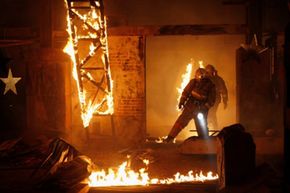You probably think of the National Aeronautics and Space Administration (NASA) as that government agency that feeds us a regular diet of mind-blowing pictures of distant nebulae, Martian landscapes and weird moons. What you may not know is that NASA's technology and expertise also helps firefighters protect your house and your family's lives every day.
It's not hard to see what astronauts and firefighters have in common. Space is an extreme and hostile environment. With high temperatures on surfaces exposed to sunlight and extreme cold in the shadows, the nature of astronaut work means that NASA has an acute interest in materials that can withstand such environments.
Advertisement
In the 1950s, Dr. Carl Marvel developed a temperature-resistant artificial fabric for the U.S. Air Force called polybenzimidazole (PBI). PBI is an artificial fabric capable of remaining stable even in extreme heat and cold. In 1963, NASA recognized the usefulness of this material for its astronauts and joined forces with the U.S. Air Force, DuPont and Hoechst Celanese for further research and development [source: Olabisi, NASA Spinoff].
In recognition of how this ongoing research could help firefighters, the International Association of Fire Fighters (IAFF) in 1971 collaborated with NASA in Project FIRES (Firefighter Integrated Response Equipment System), a coordinated effort to leverage PBI and other technology developed for astronauts. This partnership led to better protective suit fabrics and international standards that help firefighters stay as safe as possible while in harm's way. These standards later became codified in the National Fire Protection Association's official standards for Personal Protective Equipment (PPE), and they continue to help protect firefighters by ensuring that the suits they wear when fighting fires conform to tough specifications [source: IAFF].
NASA's contribution to safety didn't stop with the fabric, though. The same PBI technology also goes into making better insulation and more heat-resistant construction materials and techniques. This means burning buildings protected with that material don't collapse as quickly onto firefighters working to put out the fire [source: NASA Spinoff].
But heat-resistant fabric and construction barely scratches the surface. On the next page, we'll look at how NASA worked with firefighters to rethink the entire firefighter suit and come up with a revolutionary new design.
Advertisement



